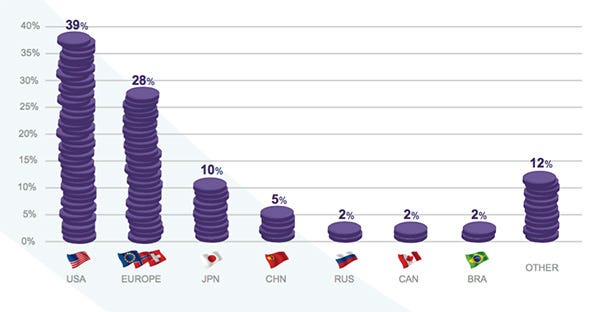Is the U.S. or Europe the True King of Medtech?
November 16, 2015
While the United States has traditionally been a global leader in the medical device field, Europe appears to be gaining ground--at least in terms of the major medical device companies based there.
Brian Buntz

Image from Eucomed
Conventional wisdom has it that the United States is still the strongest global player in the medical device industry. But a casual look at the five largest medical device companies reveals that only Johnson & Johnson has a U.S. domicile. Among the top 10, half are now based Europe, including Medtronic (Ireland), GE (Healthcare division is in the United Kingdom), Fresenius and Siemens (Germany), Novartis (Switzerland), and Philips (Netherlands).
While the United States has attempted to crackdown on so-called inversion deals, it is possible that U.S.-based firms will continue to relocate their headquarters to take advantage of the considerably lower corporate taxes there. Drug- and device-maker Pfizer's plan to buy Allergan (Dublin) could be further evidence of this trend in the healthcare space. In August, in a piece titled "Inversion Deals Retain Their Allure," the Wall Street Journal noted that inversion deals continue to be popular among U.S.-based companies. "It is recognised that Europe has a low corporate tax, and so a number of medical device companies (and companies in other industries) are moving their headquarters to Europe because of the attractive corporation tax," Marcus Gould, regulatory affairs manager at GlySure Ltd (Oxfordshire, UK), said during a conversationon LinkedIn's Medical Devices Group.
Perhaps the single-most biggest advantage of being in Europe is financial, although there are also market access advantages related to regulation.
While the corporate tax rate in the United States can be as high as 39%, some European countries have tax rates near the 10% range. Ireland's, for instance, is 12.5%, and Switzerland's is 8.5%.
However, all is not well with European medtech. The overall economy in European has been lackluster of late, while the United States' economy--and the dollar--are surging. A U.S. dollar is presently worth EUR0.94. This, however, is also dampening exports, as it makes U.S.-made products more expensive. According to Emergo's 2015 Medical Device Industry Outlook, the United States now accounts for 38% of the global medical device market.
This year alone, there was yet another financial crisis in Greece. Unemployment in countries like Spain and Italy remain persistently high, though Germany's and Switzerland's unemployment rates of 5.1% and 3.1.% are lower than that of the United States, at 5.5%.
While there have been a handful of U.S. medtech companies setting up official headquarters in Europe (Medtronic being the biggest notable example), the United States likely continues to hold a double-digit lead in terms of market share. As of 2014, 28% of the medical technology market was based in Europe while roughly 39% was in the United States, and 10% was in Japan, according to Eucomed.
Europe has slipped to third corporate in-region R&D spending, behind Asia and North America at first and second respectively; Europe was first in 2007, according to PwC's 2015 Global Innovation 1000. The difference between Western Europe's R&D exports minus imports more than quadrupled between 2007 and 2015, with money going not only to Asia but also the United States.
"Executives tell us that they want to tap into the more innovative culture of the U.S., as well as its more flexible operating environment," Barry Jaruzelski, principal at PwC US Automotive & Industrials practices, said in a news release.
After Medtronic acquired Covidien, it has gone on a spending spree, acquiring more than $1 worth of medical device startups--nearly all of which are based in the United States.
In addition, Philips is also acknowledging the innovation prowess of U.S.-based MIT, having recently inked a five-year, $25 million alliance with the university to further research in its core areas of healthcare and lighting solutions. It also has a partnership with the Academic Medical Center (Amsterdam, the Netherlands) for a European multi-center clinical study of a minimally invasive treatment for severe diabetic foot complications.
As part of its efforts to not only provide devices but also services to diabetes patients, Medtronic has acquired Diabeter, a Netherlands-based diabetes clinic and research center that is providing comprehensive and individualized care for children and young adults with diabetes.
In the positive column for Europe, the continent has been leading the United States in terms of trade balance. In 2012, Europe had a medical technology trade surplus of EUR15.5 billion while the United States' trade surplus was roughly a third as much. 41% of Europe's medical devices were sold to the United States in 2012.
And What About Asia?
While Asia's market holds huge potential growth potential, relatively few medical device companies are based there compared with the United States or Europe. Of the top 100 medical device companies, 18 are headquartered in East Asia--12 of which in Japan.
While, in general, multinational firms are investing heavily in Asia, breaking into the Asian medical has proven for many global medical device firms. Complicating matters is China's economic slowdown and the fact that China and Japan have become more difficult from a regulatory perspective.
Still, Asia is now tops for corporate in-region R&D spending, according to PwC's 2015 Global Innovation 1000.
Learn more about medical technology trends at BIOMEDevice San Jose, December 2-3. |
About the Author(s)
You May Also Like


